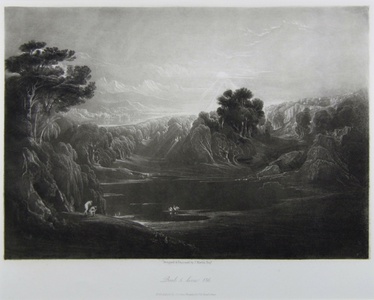| Method | Mezzotint |
| Artist | John Martin |
| Published | Published by Septimus Prowett, 23 Old Bond Street 1826. Printed by Chatfield & Coleman. |
| Dimensions | Image 191 x 277 mm, Plate 252 x 352 mm |
| Notes |
In 1824, John Martin was contracted by the London publisher Septimus Prowett to produce mezzotint illustrations to John Milton's epic poem Paradise Lost. The project carried significant risk for Prowett was not a noted publisher, nor Martin a seasoned printmaker. Subjects from Milton's great work had also been portrayed by several renowned predecessors such as William Hogarth, William Blake, Richard Westall, and Henry Fuseli, who had gone so far as to open a gallery dedicated to Milton in 1799. The series, however, was a critical and commerical triumph and stands as one of the central achievements of Martin's oeuvre. In emphasising the preternatural vistas of the text, Martin's engravings of Hell, Paradise and Pandemonium infused Milton's verse with a boldness and grandeur previously unrealised. John Martin's view of Paradise depicts a lake in the centre of the image with trees forming a pyramid on the opposite bank. Swans glide on the water, preparing to fly. Adam and Eve appear on the left, on a low hill with tall trees and weeping willows at the edge of the lake behind them. They bow in prayer as the sunlight breaks across the horizon. John Martin (1789-1854) was an English painter, illustrator and mezzotint engraver. He achieved huge popular acclaim with his historical landscape paintings which featured melodramatic scenes of apocalyptic events taken from the Bible and other mythological sources. Influenced by the work of J.M.W. Turner (1775-1851) as well as Theodore Gericault (1791–1824), Eugene Delacroix (1798–1863) and Paul Delaroche (1797–1856), his paintings are characterised by dramatic lighting and vast architectural settings. Most of his pictures were reproduced in the form of engravings, and book engravings, from which he derived his fortune. Despite his popularity, Martin's work was spurned by the critics, notably John Ruskin, and he was not elected to the Royal Academy. His fame declined rapidly after his death, although three of his best known works of religious art toured Britain and America in the 1870s: The Great Day of his Wrath (1853, Tate, London), The Last Judgment (1853, Tate) and The Plains of Heaven (1851-3, Tate). A great contributor to English landscape painting, Martin was a key influence on Thomas Cole (1801-48), one of the founding members of the Hudson River School. CW 62; Campbell, Visionary Printmaker, p. 78. Condition: Strong impression. Final state. Framed |
| Framing | mounted |
| Price | £170.00 |
| Stock ID | 28692 |

